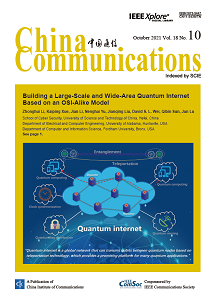基于星-无人机一体化网络的物联网数据采集优化
IF 3.1
3区 计算机科学
Q2 TELECOMMUNICATIONS
引用次数: 0
摘要
为了实现远程物联网(IoRT)中可靠、高效的数据采集和传输,研究了无人机-低地球轨道(LEO)卫星一体化天地网下,无人机在特殊场景下从海量物联网(IoT)设备中采集数据的远程物联网数据采集优化方案。为了结合实际场景,我们考虑两种不同的数据类型,即延迟敏感型数据和延迟容忍型数据,因此将传输模式分为两种。对于延迟敏感数据,数据将通过低轨道卫星中继实时传输到数据中心(DC)。对于容延迟数据,无人机将存储和携带数据,直到采集完成,然后返回DC。针对该问题的非凸性和复杂性,提出了一种多维优化速率需求联合优化(RDJO)算法。该算法首先采用逐次凸逼近(SCA)技术解决非凸性问题,然后基于块坐标下降(BCD)方法,通过联合优化无人机部署、IoRT设备带宽分配和无人机发射功率,实现数据采集效率最大化。最后,将提出的RDJO算法与传统算法进行了比较。仿真结果表明,通过对带宽分配、无人机部署和发射功率进行多参数优化,可以大大提高IoRT数据采集效率。本文章由计算机程序翻译,如有差异,请以英文原文为准。
Optimization of the Internet of remote things data acquisition based on satellite UAV integrated network
In order to achieve dependable and efficient data acquisition and transmission in the Internet of Remote Things (IoRT), we investigate the optimization scheme of IoRT data acquisition under the unmanned aerial vehicle (UAV)-low earth orbit (LEO) satellite integrated space-air-ground network, in which the UAV acquires data from massive Internet of Things (IoT) devices in special scenarios. To combine with the actual scenario, we consider two different data types, that is, delay-sensitive data and delay-tolerant data, the transmission mode is accordingly divided into two types. For delay-sensitive data, the data will be transmitted via the LEO satellite relay to the data center (DC) in real-time. For delay-tolerant data, the UAV will store and carry the data until the acquisition is completed, and then return to DC. Due to non-convexity and complexity of the formulated problem, a multi-dimensional optimization Rate Demand based Joint Optimization (RDJO) algorithm is proposed. The algorithm first uses successive convex approximation (SCA) technology to solve the non-convexity, and then based on the block coordinate descent (BCD) method, the data acquisition efficiency is maximized by jointly optimizing UAV deployment, the bandwidth allocation of IoRT devices, and the transmission power of the UAV. Finally, the proposed RDJO algorithm is compared with the conventional algorithms. Simulation consequences demonstrate that the efficiency of IoRT data acquisition can be greatly improved by multi-parameter optimization of the bandwidth allocation, UAV deployment and the transmission power.
求助全文
通过发布文献求助,成功后即可免费获取论文全文。
去求助
来源期刊

China Communications
工程技术-电信学
CiteScore
8.00
自引率
12.20%
发文量
2868
审稿时长
8.6 months
期刊介绍:
China Communications (ISSN 1673-5447) is an English-language monthly journal cosponsored by the China Institute of Communications (CIC) and IEEE Communications Society (IEEE ComSoc). It is aimed at readers in industry, universities, research and development organizations, and government agencies in the field of Information and Communications Technologies (ICTs) worldwide.
The journal's main objective is to promote academic exchange in the ICTs sector and publish high-quality papers to contribute to the global ICTs industry. It provides instant access to the latest articles and papers, presenting leading-edge research achievements, tutorial overviews, and descriptions of significant practical applications of technology.
China Communications has been indexed in SCIE (Science Citation Index-Expanded) since January 2007. Additionally, all articles have been available in the IEEE Xplore digital library since January 2013.
 求助内容:
求助内容: 应助结果提醒方式:
应助结果提醒方式:


